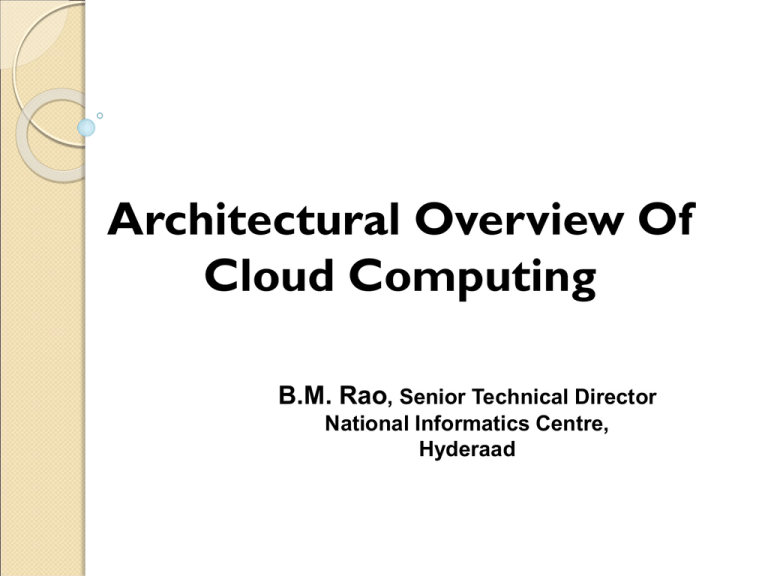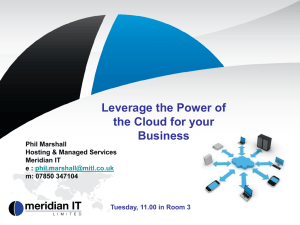Cloud Computing Archtecture
advertisement

Architectural Overview Of Cloud Computing B.M. Rao, Senior Technical Director National Informatics Centre, Hyderaad Introduction High performance networks and advanced development of internet is the basis for cloud computing . Cloud computing has started taking shape incorporating virtualization and on demand deployment and internet delivery of services. Introduction Cloud is a pool of virtualized resources networked, which can: computer Host a variety of workloads. Batch-style back-end jobs. Interactive user-facing applications. Workloads can be deployed and scaled out quickly through the rapid provisioning of virtual machines or physical machines. Support redundant, self recovering, highly scalable programming models that allow workloads to recover from many unavoidable hardware / software failures. Monitor resource use in real time to enable rebalancing of allocations when needed. Conventional Computing vs. Cloud Computing Cloud Conventional Manually Provisioned Dedicated Hardware Fixed Capacity Pay for Capacity Capital & Operational Expenses Self-provisioned Shared Hardware Elastic Capacity Pay for Use Operational Expenses Five Key Cloud Attributes: 1. Shared / pooled resources 2. Broad network access 3. On-demand self-service 4. Scalable and elastic 5. Metered by use Shared / Pooled Resources: Resources are drawn from a common pool Common resources build economies of scale Common infrastructure runs at high efficiency Broad Network Access: Open standards and APIs Almost always IP, HTTP, and REST Available from anywhere with an internet connection On-Demand Self-Service: Completely automated Users abstracted from the implementation Near real-time delivery (seconds or minutes) Services accessed through a selfserve web interface Scalable and Elastic: Resources dynamically-allocated between users Additional resources dynamicallyreleased when needed Fully automated Metered by Use: Services are metered, like a utility Users pay only for services used Services can be cancelled at any time Architecture Overview Architectural Layers of Cloud Computing In the cloud computing stack, there are three basic layers that together create cloud environment. They are: 1.Infrastructure as a Service(IaaS) 2.Platform as a Service (PaaS) 3.Software as a Service (SaaS) SaaS PaaS IaaS Service Delivery Model Examples Amazon Google Microsoft Salesforce SaaS PaaS IaaS Products and companies shown for illustrative purposes only and should not be construed as an endorsement Framework of cloud computing Application Services and built in functionality Developments tools Platform Basic middleware (database services , application server ) Virtualized resources Infrastructure Compute Networking Virtualized images Image Metadata Storage Image Software kernel (OS. VM Manager) Hardware Virtual infrastructure management and Cloud Computing For building the cloud environment a variety of requirements must be met to provide a uniform and homogeneous view of the virtualized resources. Virtual Infrastructure Management is the key component to build the cloud environment which does the dynamic orchestration of virtual machines on a pool of physical resources. Virtual infrastructure management and Cloud Computing Virtual infrastructure management provide primitives to schedule and manage VMs across multiple physical hosts. Cloud management provide remote and secure interface for creating controlling and monitoring virtualized resources on IaaS. View of Cloud Deployment Cloud Application Client Infrastructure Application Service PaaS Platform IaaS Storage Infrastructure Virtualized Application SaaS Software as a Service It is a Deployment/Delivery model • Hosted and managed by vendor • Delivered across the internet It is a Business Model : usage-based pricing(vs. perpetual license model of on –premise software).Examples: • Per user per month • Per transaction • Per GB of storage per month Software as a Service Architectural Multi-tenancy Scalability Security Performance Functional Provisioning Billing Metering Monitoring MULTI-TENANCY Multi-tenancy is an architectural pattern A single instance of the software is run on the service provider’s infrastructure Multiple tenants access the same instance. In contrast to the multi-user model, multi-tenancy requires customizing the single instance according to the multi-faceted requirements of many tenants. MULTI-TENANCY A Multi-tenants application lets customers (tenants) share the same hardware resources, by offering them one shared application and database instance ,while allowing them to configure the application to fit there needs as if it runs on dedicated environment. These definition focus on what we believe to be the key aspects of multi tenancy: 1.The ability of the application to share hardware resources. 2.The offering of a high degree of configurability of the software. 3.The architectural approach in which the tenants make use of a single application and database instance. Multi-tenants Deployment Modes for Application Server Fully isolated Application server Each tenant accesses an application server running on a dedicated servers. Application Server Tenant A Tenant B Virtualized Application Server Each tenant accesses a dedicated application running on a separate virtual machine. Shared Virtual Server Each tenant accesses a dedicated application server running on a shared virtual machine. Shared Application Server The tenant shared the application server and access application resources through separate session or threads. Application server Tenant A Virtual machine Tenant B Virtual machine Application server Application server Tenant A Virtual machine Tenant B Session thread Tenant A Application Server Tenant B Session Thread Multi-tenants Deployment Modes in Data Centers Fully isolated data center The tenants do not share any data center resources Tenant A Tenant B Virtualized servers The tenants share the same host but access different databases running on separate virtual machines Shared Server The tenants share the same server (Hostname or IP) but access different databases Shared Database The tenants share the same server and database (shared or different ports) but access different schema(tables) Tenant A Tenant B Tenant A Tenant B Tenant A Tenant B Shared Schema The tenants share the same server, database and schema (tables). The irrespective data is segregated by key and rows. Tenant A Tenant B Virtual Machine Virtual Machine Database Database Conceptual framework of Software as a Service Presentation Menu and Navigation User Controls Display and Rendering Reporting Security Application Engine Operation Identity and federation User Profile Workflow Monitoring and Altering Authentication and Single Sign on Notification and Subscription Execution Handling Backup and Restore Authorization and Role-based Access Control Metadata Execution Engine Entitlement Metadata Services Encryption Messaging Orchestration Provisioning Configuration and Customization Data Synchronization Performance and Availability Metering and Indicators Regularity Controls Infrastructure Database Storage Computer Networking and Communications Migrating to Cloud Environment The Software can be redeployed in cloud environment as Software as a Service (SaaS). The main sections of the software can be mapped to the SaaS architecture. Payroll Processing in Cloud Computing Many State Government departments are utilizing standardized set up of payroll packages which are deployed at user locations and it is amounting huge investment on procurement of hardware and software and maintenance for various locations of the organization. Payroll Software Installed at more than 300 locations User Software Module Standalone Loaded on PC Drawbacks Drawbacks : Software Maintenance problems. Individual Hardware is required. Often Data Loss occurs. Migrating the payroll package, to cloud environment can be worked out without changing business logic. IN CLOUD User-1 Software Module User-1 User-3 Single Instance Multi-tenancy Architectural Overview for Multi-tenancy Client HTTP Request Authentication Ticket Server Create Ticket() Authentication Module Session Ticket Tenant Token + Create Ticket() Tenant Auth Data Configuration Layout Component Single-tenant business logic Configuration Component Query Data File I/O Component Workflow Component Database Query Adjuster Load Balancer Record Initializer Database Pool Data Data Data Tenant Config Data Provisioning for new tenants • For Separate server model new machine is to be installed. • For separate database model create a database start it on a server. • For separate schema and shared schema models scripts / stored procedure could create new schema in one of the existing databases. Background of the Application The existing application, which is implemented in state government departments, is having the following main sections: Data admin Master data entry Month process Token no. entry Reports Back up to system The existing package is deployed in the user premises and found difficult in regular software maintenance and overhead costs for the infrastructure requirements. The application is ideally suited to deploy in cloud environment with following features: The application can be taken up as a single instance and multitenant model Configurability option in the software is required to be provided. Configurability in SaaS enables the flexibility to access the software by many tenants with the option of configuring each tenant for their application needs. The software will have configurability for the following : 1.User interface. 2.Workflow. 3.Data. 4.Access control. SaaS Applications User requirements / Use cases Type of environment in cloud Impact Payroll processing IaaS (VM) Cloud storage and SaaS 1. Processing time will be reduced. 2. Hardware requirements will be reduced. 3. Number of users can be increased with scalability. 4. Maintenance cost will be reduced. Project Management PaaS and Cloud storage 1. Processing time can be reduced. 2. Project execution time and cost can be reduced. 3. Efficient way of utilization of skill sets and manpower can be attained. e-Governance & Office automation IaaS Cloud storage SaaS 1. Hardware cost can be reduced. 2. CPU processing time can be reduced. 3. Accountability can be maintained. 4. Maintainance cost can be reduced. 5. Reduces energy consumption. e-Learning Cloud storage IaaS PaaS SaaS 1. Hardware cost can be reduced. 2. CPU processing time can be reduced. 3. Accountability can be maintained. 4. Maintainance cost can be reduced. SOA and Cloud Computing In cloud environment we adopt the bundling of resources into layers of Saas Paas Iaas And furthur add a layer for business process management with the concept of service oriented architecture(SOA). SOA is a base for furthur building of cloud environment for composite application with work flow concepts.






